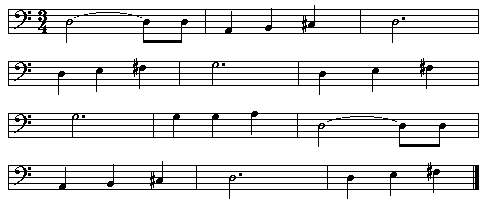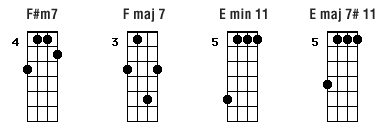Jitterbug Waltz
Will Patton
WELCOME ALL - In this debut workshop we'll take a look at Fats Waller's tune Jitterbug Waltz. I first heard this done on an old Eric Dolphy recording in the 70's but it has been performed and recorded many times on many instruments (Fats played it on a Harlem church organ). The melody lends itself to the mandolin and there are nice versions of it available by Jethro Burns and Peter Ostroushko that I know about. I have bumped the key up to D (from Db).
This melody is like a fiddle tune in that it seems to work best when played over and over, so it becomes ingrained in your "muscle memory". I've recorded an arrangement with another mandolin playing a third above, and (on the out chorus) a lead mandolin on the melody and two other mandolins playing in thirds but coming in on the last eighth note of the first measure, creating a 'round' effect. The bass line I like to use on this tune (also sounds wonderful on a mandocello for quartet players) is as follows:
Bass line:

Here are some chord voicings to try out:

On the turnaround (meas. 29-32) I use these voicings to keep the A note ringing at the top of the chords:

For the ending I usually play a ritard on meas. 61-63 (D maj 7, G min. 7, D), but there are lots of clever ways to take it out.
There are many good books on jazz improvising (I recommend Jerry Coker's books for beginners) and any in depth discussion on this subject would be outside the scope of this article, but here are some ideas for playing over these changes:
Accentuating the change from an F# in the D maj7 (meas. 1-4) to an F natural in the G 9 (meas. 5-8) gives a bluesy feeling and echoes the melody. In general the first 12 meas. of the tune alternate between good old D major scale and D Dorian (b3 & b7).
Arpeggiating or otherwise emphasizing the C7 #11 in meas. 23 provides a nice chromatic touch.
In general I am of the school of improvising thought that
treats a solo as am embellishment on the melody, and I try to refer to
it often during my solo (Lester Young, the great tenor sax player was a
master of this). So, let the melody guide you at first, keep in mind
the notes in each chord, and let your ear be the final judge.
One helpful aid to jazz soloing is to prepare a tape of rhythm
instrument & bass line, and practice playing over the chords.
Be sure to record chorus after chorus on the rhythm track to minimize
re-winding and let a groove develop.
Waltz on,
Will Patton